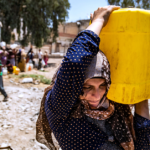The global investment and lending systems are on the cusp of a climate-oriented metamorphosis as the consequences of global warming for economies around the world become impossible to overlook.
That change should be good news, but it is the economically troubled South that could bear the brunt of this shift.
Before 2021, climate change was mainly seen as a concern that disproportionately affected the South. International financial institutions and advanced economies have committed significant amounts of their financing to climate-related mitigation and investments targeting vulnerable areas to increase their adaptive capacity.
However, the past two years have brought about a radical change. The year 2023 in particular has witnessed an unprecedented increase in the dramatic impacts of climate change in North America, Europe, the Middle East and East Asia. Prolonged heat waves, floods, raging wildfires and devastating hurricanes have hit these wealthier regions, leaving them bewildered.
Against this backdrop, it should surprise no one if wealthier countries redirect funding previously allocated to the Global South’s adjustment efforts to domestic recovery efforts.
The shift is already noticeable in mechanisms such as multilateral climate funds, as recently highlighted by the Green Climate Fund’s (GCF) struggle to secure commitments from rich countries for the coming financing cycle. To begin with, remember that there are only a limited number of dedicated sources of climate finance.
And while accessing financing through such platforms is extremely challenging, they play a crucial role and can be the only lifeline for many vulnerable regions. If these funds dry up, the Global South will no longer have doors to knock on. The Loss and Damage (L&D) Fund, which was established last year, could also fall prey to this changing landscape. To some extent that is already the case.
The fund does not yet have sufficient commitments, let alone the necessary capital, to tackle climate change. Moreover, it regularly encounters negative comments from rich countries about contributions. The United States in particular remains opposed to the idea of holding historic emitters responsible for the current climate landscape, or compensating countries hit by disasters.
It is expected that COP28 will put the operationalization of the L&D fund on the agenda. It will be intriguing to see how delegates will tackle the challenge of operationalizing a fund that is running low.
Another implication of the climate-driven transformation of financial systems, which could have the greatest impact on the Global South, relates to concessional elements within the global debt burden.
For institutional lenders such as the International Monetary Fund (IMF) and the World Bank, climate exposure is becoming increasingly apparent due to the increased likelihood of loans that borrowers will be unable to repay due to hardship.
Such challenges arise from borrowers facing recurring climate-induced disasters or depreciation of their existing assets due to the escalation of global inflation, which itself may be caused by climate change.
Lenders face a dilemma. On the one hand, their core mandate is to provide financial assistance to countries in need. However, they must also be careful when making loans to countries that may not be able to pay them back.
As a result, in a delicate balancing act, institutions are now moving away from the concessional nature of debt instruments and giving up their previous leniency.
Pakistan serves as a notable example.
Last year’s floods plunged the country into polycrises, bringing it dangerously close to a sovereign debt crisis. Ultimately, the economic collapse was averted by the IMF’s approval of a $3 billion loan program.
One would expect that the IMF would provide this amount on favorable terms to help alleviate Pakistan’s economic problems. However, the reality is exactly the opposite.
Reforms linked to the rescue package have resulted in a rise in annual inflation in Pakistan, which reached an all-time high of 38 percent in May. Interest rates have also risen and the Pakistani rupee has hit an all-time low, falling 6.2 percent against the US dollar last month.
Climate-vulnerable African countries present other examples. According to the IMF’s own assessment, thirteen African countries are currently teetering on the brink of climate and debt problems. Drought-stricken Zambia and, more recently, flood-prone Ghana have already defaulted on their debts.
The prospect of debt cancellation, a plea fervently advocated by the debt-ridden South, is not something that lenders are happy with. The climate has changed, not the principles of capitalism.
“We want to pay,” Kenyan President William Ruto said at the New Global Financial Pact Summit in June. “But we need a new financial model,” he argued. “The current financial architecture is unfair, punitive and unjust.”
To be fair, the Global South will have to rely largely on its domestic resources to drive climate investments. These countries must try to free themselves from the brutal cycle of debt and climate crises.
But to achieve this they need a financial system that is not based on the principle of ‘survival of the fittest’, but rather on equal opportunities for all.
Mere sympathy from the rich will no longer suffice. What the Global South needs, and rightly deserves, is systematized empathy.
The views expressed in this article are those of the author and do not necessarily reflect the editorial position of Al Jazeera.


